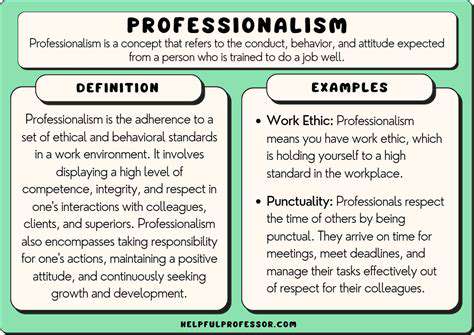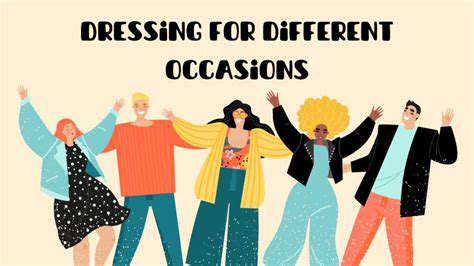The Role of Voice Tone in Personal Image
Tone and Rapport: Building Connections
Understanding the Impact of Tone
Tone of voice is a crucial element in shaping how others perceive us. It's more than just the words we choose; it's the underlying feeling and attitude conveyed through our communication style. A friendly and engaging tone can build trust and rapport, while a harsh or dismissive tone can create distance and damage relationships. Understanding the impact of our tone on others is essential for maintaining a positive personal image and fostering successful interactions.
Consider how different tones can affect a conversation. A calm, reassuring tone can ease anxieties, while a demanding tone can provoke defensiveness. These nuances are often subtle but powerful, shaping the overall impression we leave on others and influencing their reactions to us.
Verbal Tone: Beyond Just Words
Verbal tone encompasses the pitch, pace, and volume of our speech. A monotone delivery can sound uninteresting and unengaged, while a lively and expressive tone can make our message more engaging and memorable. Practicing vocal variety is key to ensuring that our verbal tone reflects our intended message and strengthens our overall communication.
Careful consideration of your tone, especially in professional settings, can significantly impact how your message is received. A professional, confident tone projects competence and credibility, while an unprofessional tone can undermine your authority and lead to misunderstandings.
Nonverbal Cues: The Silent Language
Nonverbal cues, such as body language and facial expressions, play a significant role in conveying tone. A warm smile and open posture can create a sense of approachability and trust, while crossed arms and a furrowed brow can signal defensiveness or disinterest. Being mindful of our nonverbal communication is just as important as our verbal tone, if not more so, when building rapport and projecting a positive image.
Active Listening and Responding with Tone
Active listening is integral to understanding the tone of another person. Paying attention not only to the words but also to the tone and nonverbal cues allows us to truly understand the speaker's message and emotional state. Using a respectful and empathetic tone in response demonstrates understanding and fosters a stronger connection.
Context Matters: Adapting Your Tone
The appropriate tone varies depending on the context. A casual tone might be suitable for interactions with friends, but a more formal and respectful tone is expected in professional settings. Being aware of the context and adjusting your tone accordingly is essential for effective communication and building strong relationships.
Understanding the nuances of different situations and tailoring your tone to match is a skill that can significantly enhance your interactions and build stronger connections with others. This requires thoughtful consideration and a willingness to adapt your communication style to the specific circumstances.
The Power of Empathy and Emotional Intelligence
Empathy plays a crucial role in determining appropriate tone. Understanding the emotional state of the person you're communicating with allows you to adjust your tone accordingly. A tone that resonates with the other person's emotions creates a stronger connection and fosters mutual understanding. Developing emotional intelligence is key to mastering the art of adjusting your tone to create a positive and productive interaction.
By understanding and practicing the art of adapting your tone, you can more effectively connect with others, build rapport, and leave a lasting positive impression. This understanding is a valuable asset in any interpersonal relationship, be it personal or professional.

Tone and Emotional Intelligence: Navigating Social Interactions

Understanding Tone in Communication
Tone in communication is a crucial aspect of conveying meaning and influencing how your message is received. It encompasses the emotional undercurrent and overall impression conveyed through your words, not just the literal meaning. A positive tone can foster trust and engagement, while a negative tone can create conflict and distance. Understanding the subtle nuances of tone is essential for effective communication, and it's important to be mindful of how your words might be interpreted by others. Careful consideration of tone is particularly vital in professional settings to maintain a positive and productive environment.
Tone is significantly more than just the words you choose; it's the feeling they evoke. Consider the difference between saying I'm disappointed versus I'm frustrated. While both express a negative sentiment, the latter carries a stronger emotional charge. This subtle difference in tone can impact the listener's reaction dramatically, influencing their perception of the situation and your message.
The Role of Emotional Intelligence in Tone
Emotional intelligence (EQ) plays a vital role in understanding and managing tone in communication. A high degree of EQ allows individuals to recognize and respond to their own emotions, as well as those of others. This self-awareness is crucial for understanding how your words and actions might be perceived by others and adjusting your tone accordingly. By recognizing the emotional impact of your communication, you can tailor your message to ensure it's received constructively and effectively.
Developing emotional intelligence is a journey of self-reflection and practice. It involves recognizing your own emotional triggers and responses, as well as understanding the emotional landscape of others. By practicing empathy and considering the perspectives of others, you can significantly improve the tone and effectiveness of your communication.
Effective communication hinges on navigating the delicate balance between conveying your message clearly and demonstrating empathy and understanding. This delicate balancing act requires a high degree of self-awareness and a capacity for understanding the emotional impact of your words and actions on others.
Recognizing and managing your own emotions is a key element of emotional intelligence, as well as understanding the emotions of others. This understanding allows you to tailor your tone and communication to be more effective and build stronger relationships.
Emotional intelligence and tone management are essential skills for navigating complex interpersonal dynamics in both professional and personal spheres.
Read more about The Role of Voice Tone in Personal Image
Hot Recommendations
- Grooming Tips for Your Bag and Wallet
- Best Base Coats for Nail Longevity
- How to Treat Perioral Dermatitis Naturally
- How to Use Hair Rollers for Volume
- How to Do a Graphic Eyeliner Look
- Best DIY Face Masks for Oily Skin
- Guide to Styling 4C Hair
- Guide to Improving Your Active Listening Skills
- How to Fix Cakey Foundation
- Best Eye Creams for Wrinkles

![Review: [Specific Clothing Brand] Quality and Fit](/static/images/29/2025-05/ValueProposition3AIsthePriceJustified3F.jpg)

![Review: [Specific Coat Brand/Style] Warmth and Durability](/static/images/29/2025-05/FinalThoughts3AAWorthyInvestment3F.jpg)
![Best White Sneakers for Every Outfit [2025]](/static/images/29/2025-05/ThePerfectWhiteSneakerforSpecificOccasions.jpg)

![Best Facial Cleansing Brushes [Review]](/static/images/29/2025-05/Top-RatedCleansingBrushes3AOurExpertPicks.jpg)
![Best SPF for Face: Protecting Your Skin Daily [2025]](/static/images/29/2025-05/BeyondSPF3ASupportingHealthySkinHabits.jpg)



![Best Affordable Vitamin C Serums [2025]](/static/images/29/2025-07/Serum33A5BSerumName-Example3APureVitaminCSerum5D.jpg)